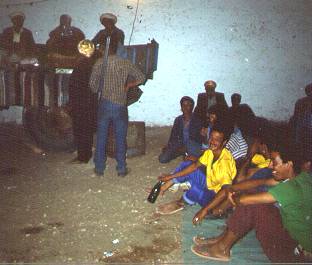The Raï of the sheikhat is a song created for libations on hot summer nights under the stars in the countryside around Oran. Leaning against the surrounding wall of a farm where a wedding night is consummated, the singer, accompanied by her musicians and "crier," tortures a microphone with her "jazzy" voice. A generator hums, bulbs sparkle, and gunpowder explodes in bouquets of sparks toward the sky. The men in the family, and neighborhood as well as young and elderly friends, arrive in cars, on motorcycles and tractors. They stretch out on the still warm earth under the arch of the sky while the alcohol flows through their veins along with the lamentations, love, pain and nostalgia. A bottle circulates, filled with the sap of the earth that their sweat has watered. Words are uttered, carrying heart-felt thoughts from tormented lives. Dedications are made: friendly, comic, aggressive, allusive, affirming and reforming alliances. Banknotes are exchanged and put forward in request of songs, reaffirming intentions, materializing the surrounding prosperity, as well as distinguishing and then reformulating the individual and the group.
The cosmic half-light which shelters the men is replaced by the sparkling of the fabrics and jewelry in a covered, well-delineated space through which the women move about.
But even in the midst of the most feminine ritual, what the singer carries in her trail is a trace of masculinity. This is, in part, owing to the fact that everyone knows that she associates with men in her work. More symbolically, however, and more profoundly, it is based on the androgynous side of her personality. A new wave chikha, Chaba Zahwanya: Qacimo, an androgynous voice: As we have seen, a sheikha no longer bears her family's name, so symbolically she no longer belongs as a woman to the patrilineage before which she would normally be held accountable both for her actions and gestures. As we have seen, she is known by her stage name, which is frequently that of an adopted place or a nickname. Her past is almost always marked by an episode in which she finds herself as a "nameless woman". Because of this, she moves about like a man. Her spatial idiom is that of a man. Like men, a sheikha smokes and drinks alcohol, and can whistle with her fingers to call on any man. A sheikha (it is also true of prostitutes, as the collective imagination more or less mixes singer and prostitute, or at least singer and "liberated woman.") cultivates the type of physical behavior prohibited in the bodily education of women and in principle the prerogative of men. She can easily spread her arms away from her body, keep her legs apart, stretch out her chest, and walk with big strides. During her performances Rimitti likes to parody a soldier's salute in the most masculine manner possible.
These gestures and postures are not only unfeminine, they emphatically mimic masculinity and male dominance. The male proxemic code is the almost complete appropriation of the body language through which men often express their superiority, and which enables them to occupy a larger space than that of women. It does not require hiding a body that must normally be made discrete; instead it displays a body that is imposing and impressive. Some sheikhat go so far as to transgress taboos regarding the use of musical instruments. As a rule, in the Oran region—and in the Maghreb in general—women could only use percussion and given string instruments. But Raï women singers do at times touch the flute, regarded as the masculine instrument. Finally, the lyrics of the sheikhat's songs are of the kind that no woman can pronounce in public, especially in front of a male audience. As we shall see, just like men they sing of love, including physical love, adultery, or even casual sex; they sing of the pleasures of alcohol and soirées in which the men and women mix. These themes intertwine with laments and religious evocations, which are more in tune with the usual register of feminine songs. The combination of sacred and profane and of masculine and feminine discourses is even more fascinating as it is juxtaposed without transition as a textual patchwork. Transgressively, the sheikhat's singing unites the most feminist aspirations: it does so by overturning hierarchies and sexual protocols in expressing women's desire for men — a desire hardly present in the Maghrebi oral tradition. They have invented the blazons of the masculine body and an egalitarian eroticism. |




